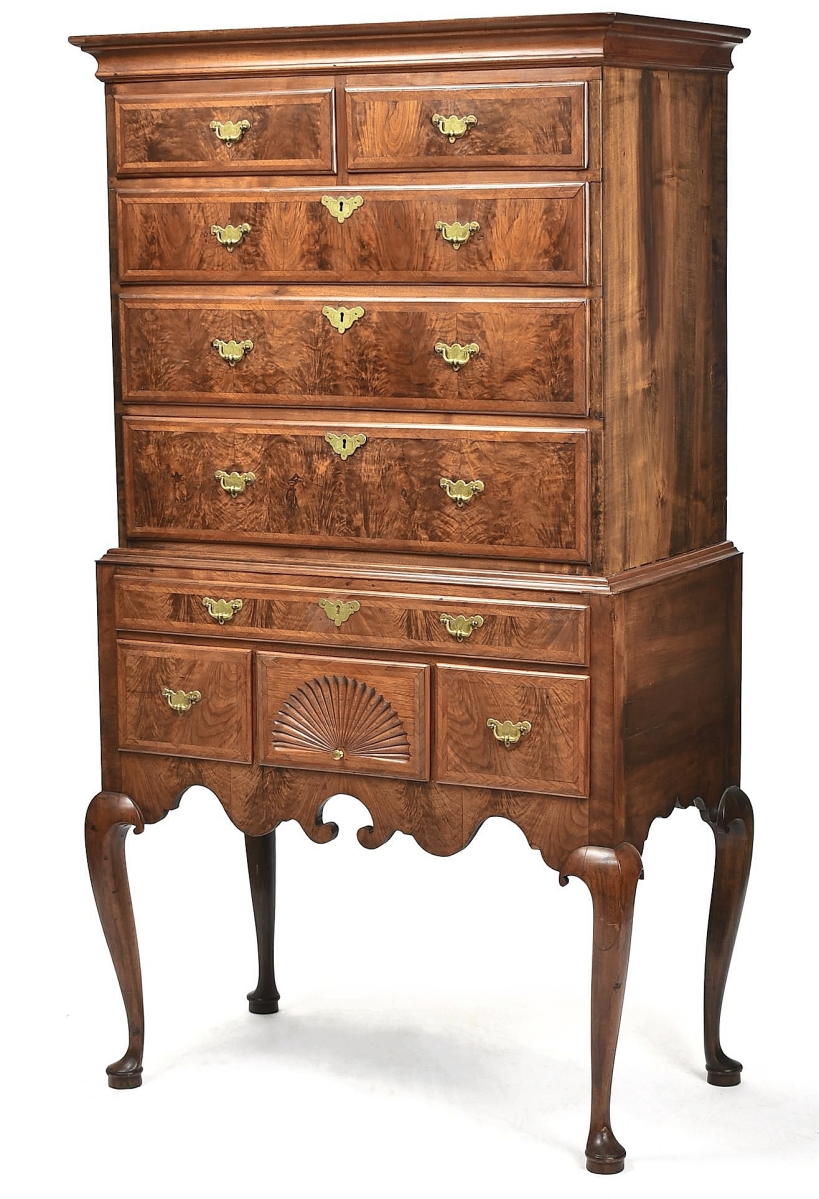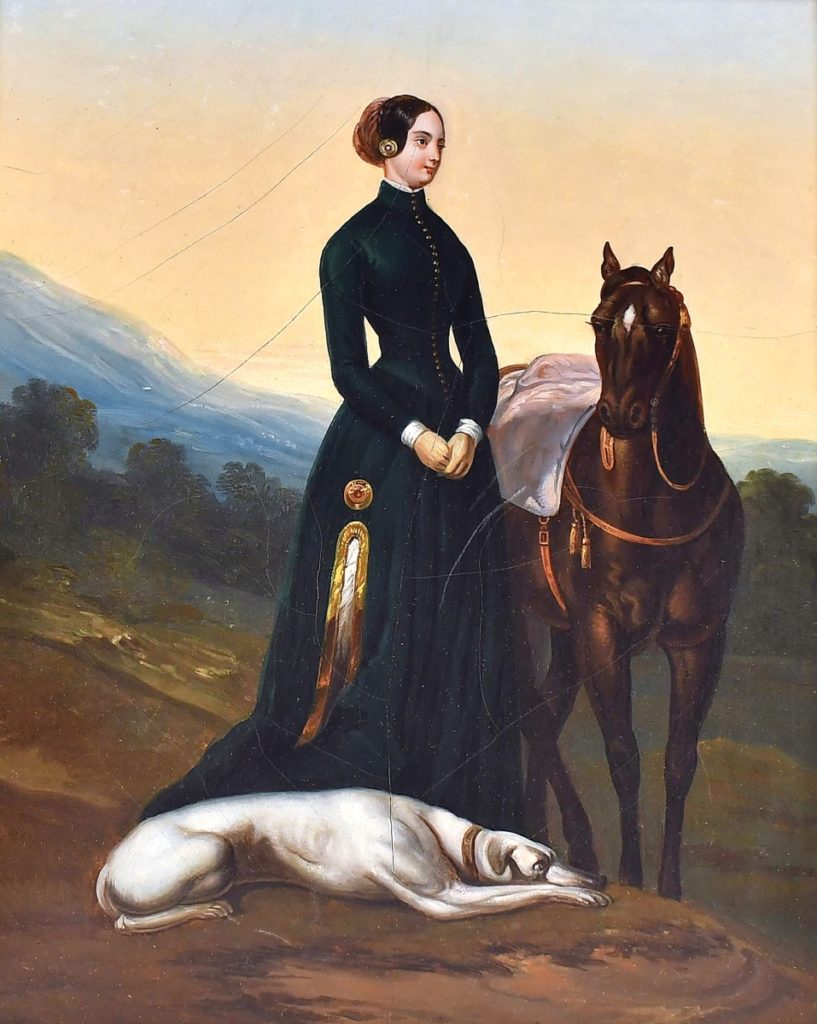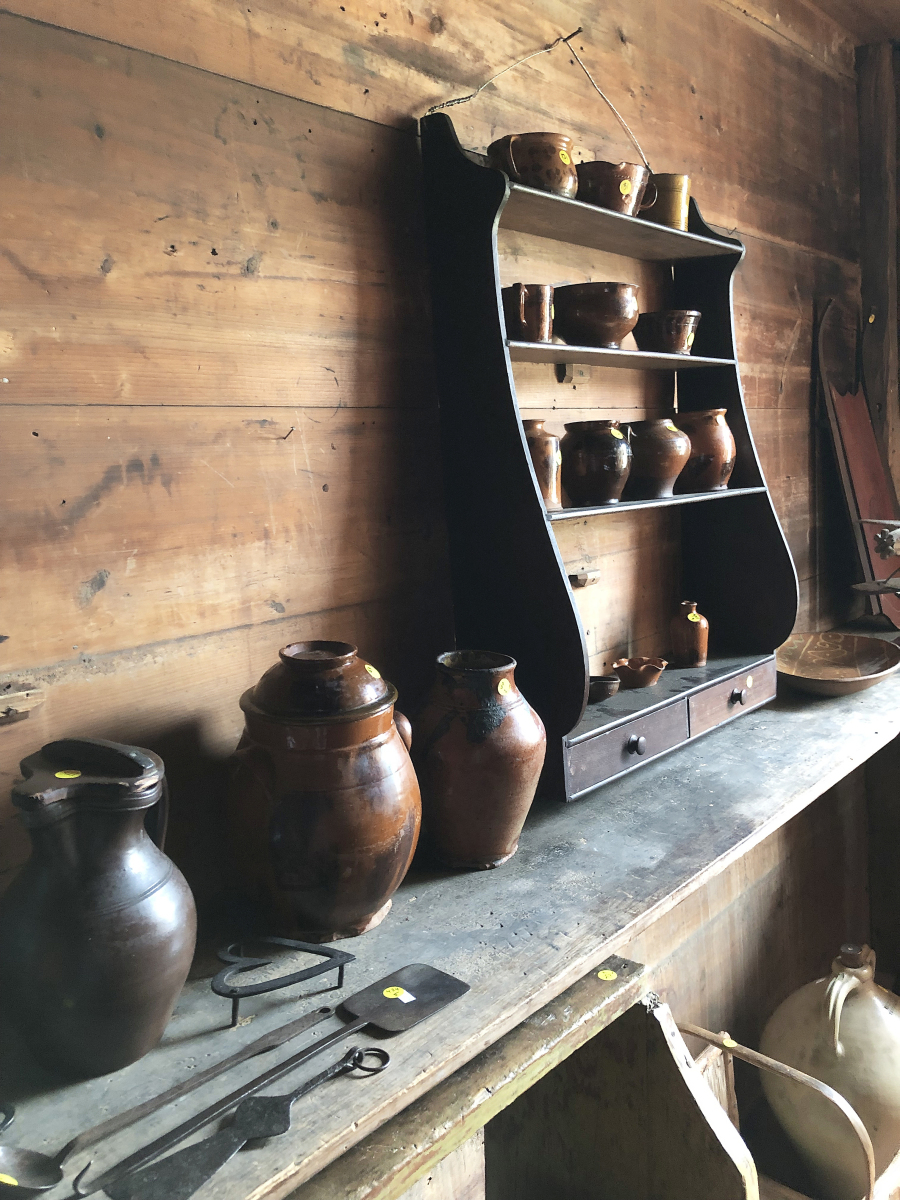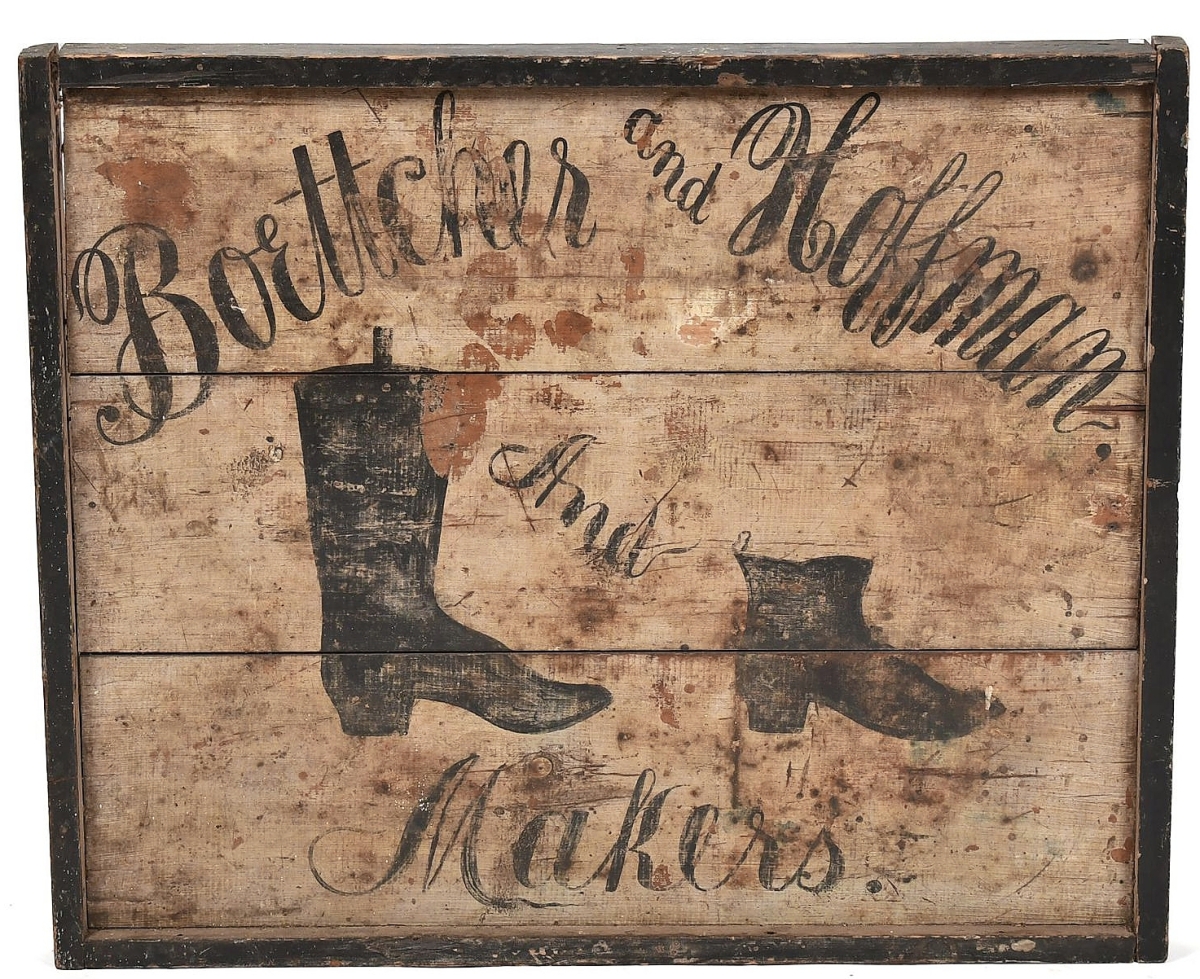
Although this Boston Eighteenth Century Queen Anne highboy was a married piece, it was good looking. It had walnut drawer fronts with cross banded inlays, maple sides and a fan-carved center drawer. It realized $4,425, the highest result of the day.
Review and Onsite Photos by Rick Russack, Additional Photos Courtesy W.A. Smith
PLAINFIELD, N.H. – Bill Smith timed this sale perfectly. The sale did not have items that were expected to sell for five or six figures, but it had wonderful folk art, redware, needlework, trade signs, decoys, painted furniture, woodenware and more. And with the sale conducted on August 5, there was plenty of quality stuff of interest to dealers doing the New Hampshire shows August 7-13. Much of the material was from the collections of Harvey and Sandy Sussman, who spent summers in Vermont each year from 1976 to 1986. The Sussmans shopped all the major dealers and shows in Vermont, New Hampshire and Maine, along with small tag sales and wherever else they might find things. Smith decided to set up the material for viewing in the “French House,” a circa 1820 house on the site of his gallery, instead of in the gallery as he normally does, so that attendees could “see how early American life looked from inside an 1820s homestead.” It was a great bit of creative marketing.
The “French House” was bought by Bill Smith’s father in the 1980s and moved to the gallery site from its original location in Grafton, N.H., Smith said, “Dad wanted to hold auctions in it and eventually live in it. But the living in it part didn’t work out. We’ve used it for previews like this from time to time, and we use it for storage. It’s a great old house.” It is that. It’s a one-and-a-half story, center chimney, post-and-beam home with some paneled walls, chair rails, built-in cupboards, fireplaces and other early features. The Sussman collection, along with other items in the sale, displayed beautifully in the house. The gallery site has an interesting history. Bill Smith Sr, who founded the business in 1962, bought the property, which included the town’s fire station and school, and set up business. The schoolhouse was enlarged and today is the main auction gallery, although at this time of year, sales are conducted outdoors under a tent. The firehouse remains and is used for some previews and also for storage.
There were several unusual trade signs and weathervanes, some of which sold well above the estimates. Topping the trade sign selection was a wood advertisement for the firm of Boettcher & Hoffman, bootmakers. It was a nicely weathered wood sign, bearing the company name and paintings of a boot and a shoe. The bootmaker’s sign sold for $3,304. A bit more unusual was a Nineteenth Century blacksmith’s sign from the workshop of J.A. Kiefer. It had a painted sheet iron horse, with a horseshoe hanging from it and the shop name on a banner. The word “Practical” was hand lettered across the horse, perhaps its name? The sign realized $2,950.

Bidders appreciated a small, unsigned Nineteenth Century painting of a well-dressed woman in a green riding costume with her horse and dog. It sold well over the estimate, finishing at $2,714.
Weathervane collectors had seven from which to choose, including a scarce one, possibly made to order, in the form of an angelfish. It was of green painted sheet metal, 22 inches tall and it sold for $2,478. More traditional forms included a full-bodied rooster, signed A.L. Jewell, Waltham, Mass. The rooster, 22 inches tall too, had legs of zinc and earned $1,416. Another rooster, again 22 inches tall, was a full body copper example perched on an arrow, with original gold gilding and a red painted crown and beard. This one found a new owner who paid $1,298 for it.
Furniture selections included the two highest priced items in the sale. One was a married Eighteenth Century Queen Anne highboy selling for $4,425, and a circa 1830 paint-decorated deacon’s bench from Pennsylvania, which sold for $3,540. A painted backless bench, circa 1830, with a Boston label realized $3,422, and an 1820s poplar two-part country Welsh dresser from Pennsylvania realized $3,304. The top had two eight-light glass doors and a light blue painted interior.
The Sussmans had a good eye for folk art. One of the exceptional offerings was a 44-inch-wide diorama with an early carved and painted wood steam engine, “The Boston,” pulling a tender and a passenger car. There was also an engineer, working without a cab, iron wheels and smoke billowing from the engine. It was painted green and blue and sold for $3,068. A pencil and ink miniature portrait on paper attributed to Raphaelle Peale realized $3,186. Early Noah’s arks are a perennial favorite with folk art collectors, but the animals are a challenge to display as they keep falling over. The sale included one that belonged to a clever earlier collector who had solved that problem. The ark and the numerous trees, Noah and the animals were mounted on shelves in a canted Nineteenth Century wall cupboard and were glued to the shelves. It sold for $1,180.
There were 30 pieces of redware and 22 needlework samplers. An intricate sampler made by Jean Stephen Stewart, Montrose, June 1839, depicting a large stone house with dogs, a peacock and a floral border earned $1,062. Dates on others ranged from 1802 to 1842. An 1812 example by Ann Alexander, with a house, animals and trees, earned $1,534, and an 1802 Stetson family register with details on 14 children earned $944. All the samplers sold.

Much of the redware was displayed in the paneled old French house buttery.
Of the redware, three lots each reached $1,180. One was a Nineteenth Century slip-decorated 11-inch plate with a large star in the center and a heart border. One was a lot of two pieces – a bird whistle sold with a redware slice of watermelon. The third piece bringing that amount was a 4-inch-tall mug decorated with yellow slip on the outside, with green and orange spots on the inside. Redware scholar Justin Thomas later said he thought the mug was made in the 1700s somewhere in coastal Massachusetts. Its provenance included Stephen-Douglas Antiques but Steve Corrigan, who was in the audience, said, “Believe me, I didn’t get that kind of money when I sold it. Must have been more than 40 years ago.” Only one lot of the redware was passed. Thomas said that there were some bargains to be had within the redware selection.
It was the sort of sale where those attending the preview on the day of the sale really had to poke around carefully. There were numerous treasures, difficult to classify, inside cupboards and on shelves. A sewing caddy carved in the form of a pair of lady’s boots sold for $2,360. A pair of painted treen covered jars sold for $2,596. A carved Micmac birch bark log carrier decorated with numerous animals and attributed to Tomah Joseph sold for $3,068. This is a list that could go on and on.
The day after the sale, Harvey Sussman said that he and his wife were very pleased with Smith and the results of the sale. “Unfortunately, none of our children were interested in the things we loved. We’re getting on in years and decided that since the kids didn’t want any of it, we’d sell it. We chose Bill Smith because we often used to go to auctions there, but it was Bill’s father in those days. Bill and his staff were a pleasure to deal with and they made everything simple for us. They came down here (Texas) with a large truck, packed the things carefully, and the final sales figure was more than Bill told us to expect.” When Sondra Sussman was asked which was their personal favorite item in the collection, she said, “That’s a really tough question. It would have to be the six treen covered jars. They were in our kitchen, and we saw them every day. Our love was really the Americana items in the collection.”

Trade signs were popular with bidders. Bringing the highest price of the group, $3,304 was paid for this example for bootmakers Boettcher & Hoffman.
After the sale, Bill Smith said, “We have happy consignors for this sale and happy customers. The tent wasn’t filled like the old days, but we had a good crowd and a lot of the stuff was sold to the room. We did about $300,000, which is about what we were expecting. We’ve added people to our staff and we’re now able to take advantage of social media for attracting the younger crowd. I’m planning on us growing substantially in the near future and I’m hoping to secure larger, quality collections. Now that we have a Stamford, Conn., location, it makes it simple for folks in that area, including Westchester County, to do business with us online. They’re able to pick-up their purchases near where they live.”
Prices given include the buyer’s premium as stated by the auction house. For information, www.wsmithauction.com or 603-675-2549.


































